|
MARCH 2022
|
|

Women's
Suffrage Poster
(digitally restored)
New York
State
Library
|
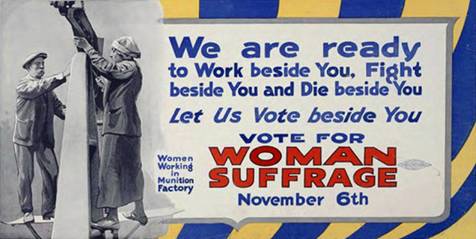
|
|
Every year, do you celebrate what happened on November 6, 1917?
Maybe you should.
On that day, the voters of the State of
New York
(all of them men, incidentally) decided that thereafter, women
would be entitled to vote in all elections held in the state.
Getting things changed took a lot of work by a lot of
people - and some people in
Hicksville
were part of it.
|
|
***
|
Introduction
At the start of 1917, female American citizens who resided in any state
east of the Rockies (except
Kansas
) had no vote, or only a limited vote.
Among those states were four of the nation's most populous:
Michigan
,
Ohio
,
Pennsylvania
, and
New York
. During 1917, one of those
four,
New York
, voted to open its ballot boxes equally to men and women.*
|
*Note that other constraints still remained.
For example, many Chinese, whether male or female, were
still denied citizenship, and thus were not eligible to vote.
|
|
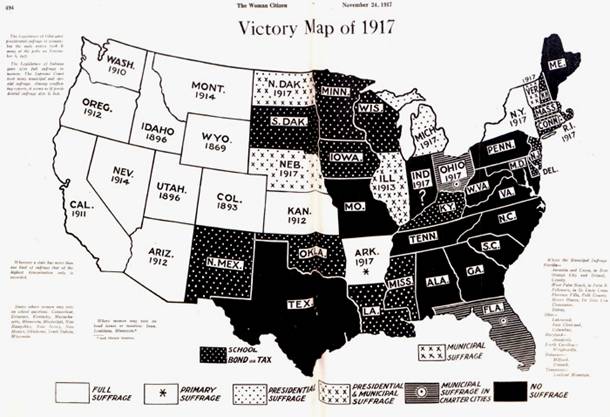
|
|
The
Woman Citizen, November 24, 1917
|
Above is an end-of-1917 map.
Starting with the line of states that extends from
Minnesota
through
Louisiana
, and heading towards the
Atlantic
, there are thirty-one states. By
this time, some had taken timid first steps towards women's suffrage.
Incredibly,
New York
was the ONLY state of the thirty-one to have granted unrestricted
suffrage to women!
There were many reasons, including the significant contributions being
made by women to the country's war effort in 1917-1918, why the idea
of full women's suffrage would continue to gain national support, but
the victory in
New York
- the first in any of the original thirteen
United States
- was symbolic and inspiring. It
showed
America
that the issue of women's suffrage need not divide the country between
the West and the East, or between the Old states and New.
Obviously, the saga of women's
suffrage in
America
is not in itself a
Hicksville
story - but it is interesting to see how things played out locally.
The nation's cities may have hosted the
biggest parades and conventions, but all across country, in towns and
villages like
Hicksville
, people worked for years, organizing small lectures and meetings,
sustaining public interest, debating with anti-suffragists, and
garnering funds as well as people's support.
Let's take a look.
The Political Equality League
In the late 1870s, efforts to add a Women's Suffrage Amendment to the
U.S. Constitution had failed. It
took time for proponents to build new momentum.
By the 1890s, mention of the subject again appeared with some
frequency in the press, in part because suffrage had been granted to
women in other countries, such as
Australia
.
Across
America
, a network of local support groups was coalescing.
This organized yet "grass roots" approach tapped into
regional and national suffragist resources, providing even small towns
with speakers and informative printed literature.
The earliest instance I have found of this network's reaching
Hicksville
dates from 1911:
|
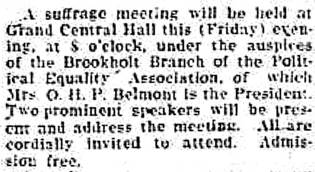
|
|
Huntington
Long-Islander, June 23, 1911
|
|
A
few notes:
Mrs. Belmont was the
sister-in-law of August Belmont Jr., who had lost the battle for
the trolley franchise that then was about to link Hicksville to
towns as far west as Flushing; v. Ancient
Hixtory August
2018 at 1808/hixtory.htm
She previously was married
to Willie K. Vanderbilt of racing fame; v. Ancient
Hixtory February
2019 at 1902/Hixtory.htm
Brookholt was the name of
the O. H. P. Belmont estate in
East Meadow
.
|
Alva
Belmont was an ideal person to promote the suffragist cause; she was
locally prominent, respected, wealthy, and widowed.
She could give the cause all the time and money she wished, and
she could lead by example, encouraging other women to do the same in
their own respective towns. People
like Alva Belmont made the suffragist cause contagious.
We cannot tell with certainty what followed
her June appearance, but there likely were many telephone calls,
invitations to tea, and planning sessions throughout the summer and
autumn. Come December, a
coordinated Nassau County Women's
Suffrage Campaign began, with meetings held in Farmingdale, Mineola,
Oyster Bay,
Hicksville
, and several other towns during the first half of December.
The coordinator of these meetings likely was Jessie Hardy Stubbs,
well-known women's suffragist and pacifist who traveled from coast to
coast. In a few months she
would hike from
Manhattan
to
Albany
, to present a letter in support of women's suffrage to the Governor.
Evidently, Stubbs found a willing
audience in
Hicksville
. She returned eight days
after her first visit, sat down with a group of interested volunteers,
and
Hicksville
's chapter of the Political
Equality League was formed. Its
President was Johanna Taliaferro - like Alva Belmont, Taliaferro was locally
prominent, respected, wealthy, and widowed.
Note that the new chapter's Lydia Kraemer was already the head
of the local Women's Christian
Temperance Union, a group which favored women's suffrage.
|
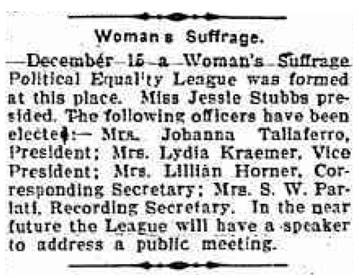
|
|
Huntington
Long-Islander, January 5, 1912
|
|
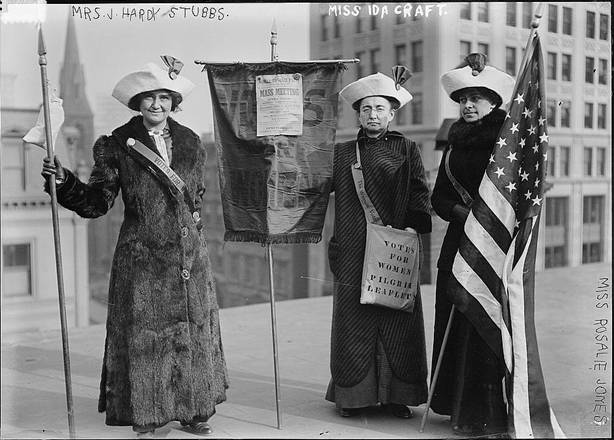
|
|
Publicity
photo for a Brooklyn leaflet campaign;
rooftop of the
Academy
of
Music
, c.1910
Wikipedia
Commons
|
|
***
|
Johanna Augustin Taliaferro
Pssssst!
Don't worry; you can give your tongue a break.
The surname Taliaferro is generally pronounced Tolliver (see the Appendix to this article).
|

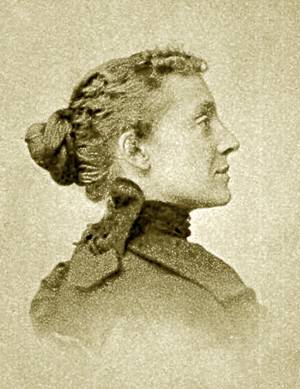
|
|
Johanna
Augustin Taliaferro
July 26, 1872 - June 14, 1964
"digitally
restored" versions of online images found in the
Hicksville
Public Library Collection at nyheritage.org
|
|
*
|
She was the first daughter of Frederick
Julius Augustin, one of the early German settlers of
Hicksville
who rose to prominence. He
was a man who went quickly from one success to the next.
He published a newspaper in German for his fellow immigrants, but
left it for a new challenge: establishing a thriving retail business.
He sold the business once the challenge was gone, and decided to
retire young. His concept of
retirement did not differ substantially from what we would consider
working. He settled into an
impressive home, and soon added a retail lumberyard and coal yard to the
property. He remained active
in church and fraternal activities, and he also served as a TOBAY Justice
of the Peace.
In the picture of the young Johanna,
above, she reminds one of her father, as seen in a portrait in the
Evers' book on
Hicksville
. She too looks thoughtful,
accepting rather than determined, and not at all carefree.
That's understandable. Her
young mother, Johanna Freytag Augustin, had died four days after giving
birth to Johanna. Julius
must have done everything in his power to get his wife the best medical
attention, for she died in
Manhattan
, probably in a hospital.
New York City
records say that she was only eighteen.
Like her mother, Johanna Augustin married at seventeen.
Her husband, Dr. Fontaine Newton Taliaferro, had been born in
Virginia
; he practiced in
Hicksville
and served as Coroner. A son
was born four years after they married, and given his father's name.
Fontaine Sr. became ill and died nine months after becoming a
father. The following year,
the new widow's father Julius, fifty-seven years old, died after a
struggle with kidney disease. Johanna
moved in with her grandmother Freytag.
She would never remarry.
By the time the renaissance of
women's suffrage activity was reaching its height, Johanna Taliaferro
had become an officer of Plainlawn Cemetery, had lost a bid to be
elected to the School Board (perhaps because Hicksville did not elect
women to the School Board in those years), had become a founding member
of the first Rebekah Lodge (part of the Foresters organization) in
Nassau County, had donated a new bell to the Methodist Episcopal Church,
and was developing or selling idle properties that had belonged to her
grandmother. Part of the
latter effort included her becoming proprietor of the Kenmore Hotel on
West Marie Street
. She pleased
Hicksville
's townsfolk by having cement sidewalks poured from Broadway to
Jerusalem Avenue
on the north side of
Marie Street
.
Clearly, this was the kind of woman whom the movement had wanted to
recruit.
On August 23, 1912, Teddy Roosevelt's
Progressive Party - aka the Bull
Moose Party - held a "mass meeting" in
Hicksville
's Grand Central Hotel. On
the agenda was an address by a government official, who explained the
legal issues to be faced by efforts to establish women's suffrage in
New York
State
. This was not surprising
- at the party's recent convention, some "upstarts" had
succeeded in revising the party platform to be in favor women's
suffrage.
The following month, the largest Mineola Fair to date was held.
Yellow, the color adopted by the suffragist movement, was much in
evidence - there were yellow banners, yellow placards, and even yellow
cars owned by "suffragettes." Johanna
Taliaferro was there, working the crowds along with dozens of other
women, signing up supporters.
On the eve of the November election, William Sulzer, Democratic (and
soon-to-be-victorious) candidate for Governor, arrived in Hicksville by
train, and made a brief last-ditch speech, presumably from the open
platform of an observation car. An
uninvited suffragist deliberately drove up at the same time to poach the
crowd, addressing it from her yellow touring car.
|
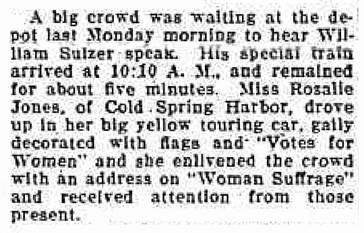
|
|
Huntington
Long-Islander, November 8, 1912
|
The next day, however, the voters again
did not choose to grant
New York
women suffrage. Part of the
difficulty lay with the simultaneous promotion of Prohibition by women;
men who otherwise might have considered supporting women's suffrage
feared that, if allowed to vote, most women would be pro-temperance.
On to the Final Rounds
With the 1912 election over, the
movement looked ahead, seeking new ways to move forward. Local groups
began to yield the floor to larger regional events that attracted more
attention, but even so, the villages were not to be forgotten.
On May 24, 1913, there was a Votes
for Women Pageant, in which five hundred women paraded from Mineola
to
Hempstead
.
|
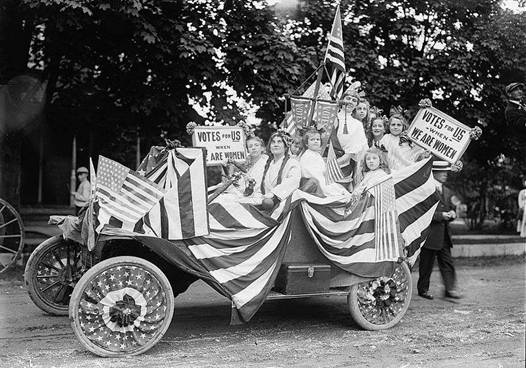
|
|
There
were two official Grand Marshals for the parade, both male.
Each had
distinguished himself working to advance women's suffrage.
One was in the parade; the other flew his plane overhead;
note how the driver in the photograph is looking skyward.
https://msmagazine.com/2020/05/24/today-in-feminist-history-votes-for-women-and-parades-too-may-24-1913/
|
Although pageants and parades attracted
people, not everyone could - or would want to - go to see them.
Thus, a new suffragist phenomenon was introduced to
Nassau
County
on that day: the Flying Squadron.
Clusters of automobiles visited more than twenty villages,
including
Hicksville
, while the pageant was taking place.
At each stop, suffragist speakers told the people who had
gathered that the movement would continue, and explained to them why
they ought to support it. The
work would go on as long as necessary, until victory was won.
|
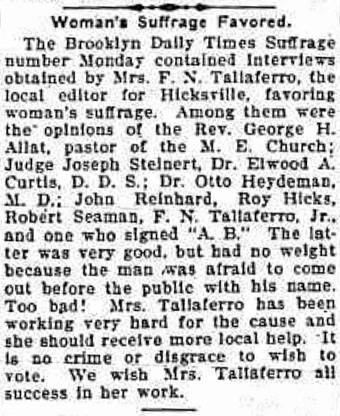
|
|
Huntington
Long-Islander, June 11, 1915
|
There were suffragist bake sales, and
suffragist speakers at the Hicksville Fire House, sometimes presented in
conjunction with the
Jericho
Political Equality League.
That fall, women's suffrage again was defeated at the polls,
and the local margins of loss remained significant.
Judging by the newspapers, the suffrage movement
was quiet in 1916 - or perhaps it was merely preempted
by news of the continuing war in
Europe
. By 1917, however, the
movement was again looking ahead to an autumn vote in
New York
State
. The first sign of new life
appeared in the newspapers in February, when two women spoke at a
meeting in
Hicksville
's Town Hall, discussing the benefits which other jurisdictions had
experienced after granting voting rights to women.
In May, the New York State Women's
Suffrage Association held a "Long
Island Suffrage Rally" at the Garden City Hotel.
The local newspapers pointed out that Hicksvillians could easily
get there by automobile, train, or trolley.
Storage
Jars Help Make the Difference
Suddenly, things were different -
with the country going to war, it needed all the help that women could
give. In a story somewhat
reminiscent of a Monty Python
episode, it was reported that women all over
Long Island
had been transformed into vital wartime resources, and now were
efficiently preserving vast quantities of food in jars, thanks to the Food Reserve Battalion.
|
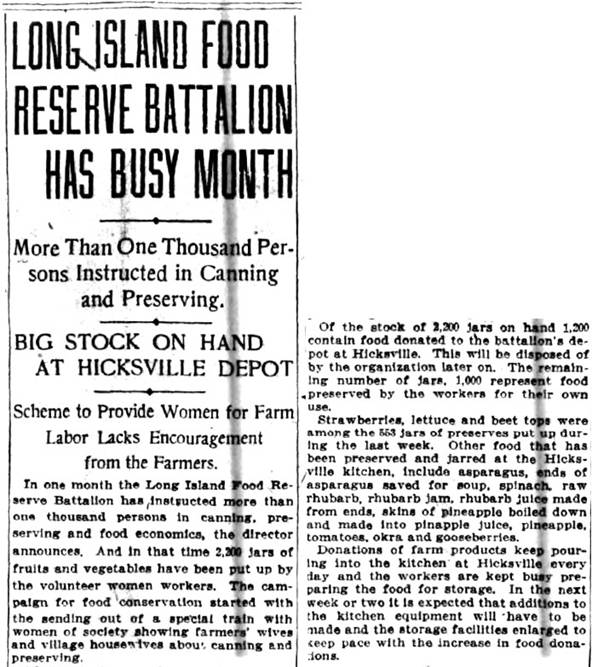
|
|
New
York
Herald, July 8, 1917
|
With women contributing so visibly to
the war effort, many men on the home front faced a dilemma.
Even if they opposed Prohibition, would their consciences allow
them to vote against women's suffrage come November?
Some among them, perhaps less generous in spirit, faced a slightly
different version of the same problem.
Men were registering for the draft; others were enlisting.
Women were already working at various jobs men had vacated.
If you lived in a small rural town, and everyone knew that you
liked to drink your beer or your liquor once in a while, and women's
suffrage was again rejected at the local polls, everybody -
"everybody" now being mostly women - was going to start looking at
you a lot less kindly, because they pretty much knew that you'd voted
against it. Just saying.
The
Hicksville
page of the Long-Islander of
October 12, 1917 mentions an upcoming "big suffrage rally in
Fireman's Hall." Of
greater interest is a separate article on the same page.
After receiving a petition signed by nearly 14,000
Nassau
County
women who could gain the right to vote after the upcoming election, the
County
Board
of Supervisors officially
endorsed the proposed amendment to the State Constitution.
Two weeks later, enthusiasm ran high as another women's
suffrage meeting was held at the Town Hall.
On October 20, the Sea Cliff News
reported that many
Nassau
County
women would be taking part in the
New York City
suffrage parade scheduled for one week later.
The report claimed that the parade might well "outstrip" any
similar parade previously held anywhere in the
United States
- and perhaps it did. It
was not the showiest suffragist parade ever, but it may have been the
most dignified, and it was very suitable for wartime.
It took 2½ hours for the 25,000 marchers to pass any given
point. The paraders carried
the signatures of more than 1,000,000 women who had petitioned for the
right to vote.
The thoughtful words below convey very well how things had changed.
|

|
|
excerpt
from 25,000 SUFFS WIN
CHEERS IN PARADE
The
Brooklyn
Daily Eagle, October 28, 1917
|
Most of the excerpt above is clear.
For those readers who want to know what Service Flags were, and
the significance of the stars they carried, I refer you to one of the
first articles in this series: Ancient Hixtory June 2018 at 1806/hixtory.htm
Back Where We Started
There was a large voter turnout, and as always, people wanted to find
out what happened as soon as possible.
Radio had not yet come along, so many people in the City gathered
in
Times Square
- where the NY Times still
had its own building - to see the results as soon as they were flashed
to the public.
|
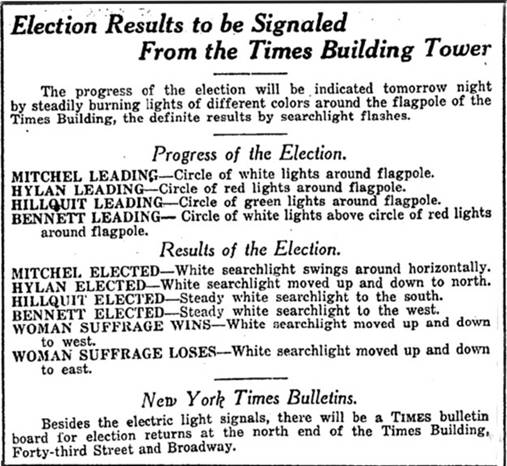
|
|
Easy
as pie, right?
New
York Times, November 5, 1917
|
The
white searchlight waggled to the west; the suffragists finally had
carried
New York
. It would not be long until
the U.S. Constitution was similarly amended.
Appendix
|
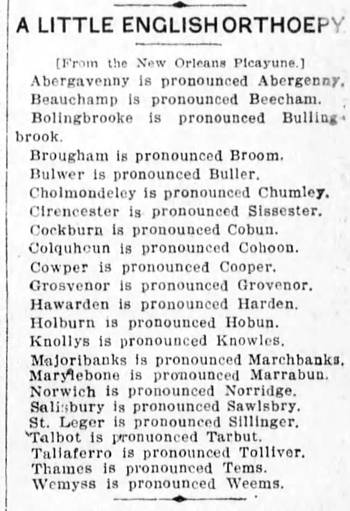
|
|
The
Brooklyn
Daily Eagle, February 7, 1911
|
|
*****
|
That's
it for March!
|














